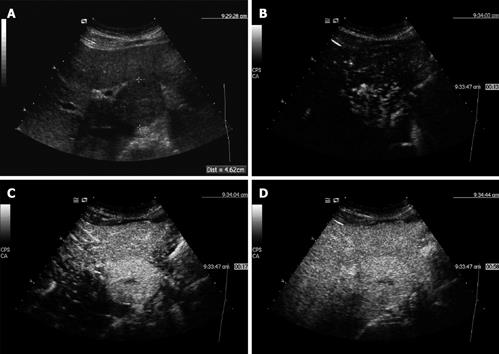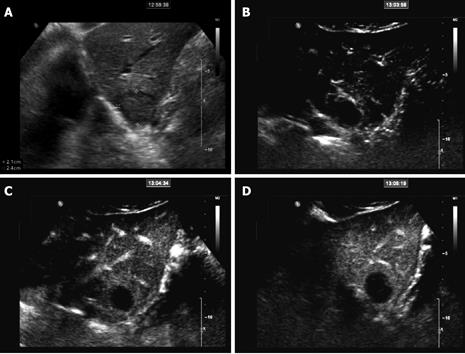Copyright
©2009 The WJG Press and Baishideng.
World J Gastroenterol. Aug 14, 2009; 15(30): 3748-3756
Published online Aug 14, 2009. doi: 10.3748/wjg.15.3748
Published online Aug 14, 2009. doi: 10.3748/wjg.15.3748
Figure 1 45-year-old female patient.
A: 4.6 cm isoechoic lesion in segment 1 found in B-Mode sonography; B: Contrast-enhanced sonography with SonoVue® showed an early arterial enhancement with radial intratumoral vessels seen 13 s after injection; C: Strong enhancement of the whole lesion after 17 s, with a central scar becoming visible; D: In the portal phase, the lesion becomes isoenhancing with the surrounding normal liver tissue. The enhancement pattern is typical for a focal nodular hyperplasia (FNH).
Figure 2 36-year-old female.
A: 4.0 cm hypoechoic lesion in segment 8 found in B-Mode sonography; B: Contrast-enhanced sonography with SonoVue® showed a peripheral enhancement with nodular contrast accumulations 14 s after injection; C: Slow progression of the enhancement from the periphery towards the center of the lesion, with a broader peripheral enhancement zone seen at 20 s; D: After 1.5 min, the lesion is completely filled with contrast and appears hyperenhanced compared to the surrounding normal liver tissue. The enhancement pattern is typical for a hemangioma.
Figure 3 44-year-old male patient with a history of rectal carcinoma.
A: 2.4 cm isoechoic lesion in segment 2/3 found in B-Mode sonography; B: Contrast-enhanced sonography with SonoVue® showed a distinct rim enhancement in the peripheral zone of the lesion 13 s after injection, representing the abnormal arterial supply of the lesion; C: Early washout of the contrast enhancement in the portal phase and lack of any portal enhancement resulted in a hypo enhancement of the lesion compared to the surrounding normal liver tissue; D: In the late phase, complete lack of enhancement within the lesion (black spot) allows a clear discrimination of the lesion from the strongly enhanced normal liver tissue. The enhancement pattern is typical for a hypovascular metastasis.
- Citation: Trillaud H, Bruel JM, Valette PJ, Vilgrain V, Schmutz G, Oyen R, Jakubowski W, Danes J, Valek V, Greis C. Characterization of focal liver lesions with SonoVue®-enhanced sonography: International multicenter-study in comparison to CT and MRI. World J Gastroenterol 2009; 15(30): 3748-3756
- URL: https://www.wjgnet.com/1007-9327/full/v15/i30/3748.htm
- DOI: https://dx.doi.org/10.3748/wjg.15.3748











